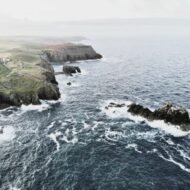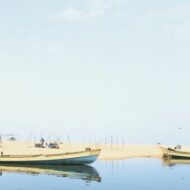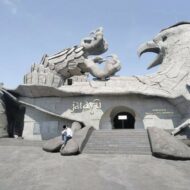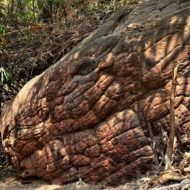Belem Tower or the Tower of St Vincent is a fortified tower located in the civil parish of Santa Maria de Belem in the municipality of Lisbon, Portugal.
It is a UNESCO World Heritage Site (along with the nearby Jeronimos Monastery) because of the significant role it played in the Portuguese maritime discoveries of the era of the Age of Discoveries. The tower was commissioned by King John II to be part of a defence system at the mouth of the Tagus river and a ceremonial gateway to Lisbon.
The tower was built in the early 16th century and is a prominent example of the Portuguese Manueline style, but it also incorporates hints of other architectural styles.The structure was built from lioz limestone and is composed of a bastion and a 30-metre (98.4 ft), four-storey tower. It has incorrectly been stated that the tower was built in the middle of the Tagus and now sits near the shore because the river was redirected after the 1755 Lisbon earthquake. In fact, the tower was built on a small island in the Tagus River near the Lisbon shore
History : In the late 15th century, King John II had designed a defence system for the mouth of the Tagus that depended on the fortresses of Cascais and Sao Sebastiao (or Torre Velha) in Caparica on the south side of the river. These fortresses did not completely protect the river’s mouth, and further protection was required. In his “Chronicle of John II” (Chronica de D. Joao II), which appeared in 1545, the author Garcia de Resende affirmed the king’s opinion that the defences of Lisbon were inadequate, and that he had insisted on building fortifications along the entrance to the River Tagus to supplement the existing defences.To this end, he ordered the “making of a strong fort”, but died before any plans were drawn. King Manuel I of Portugal revisited the proposal twenty years later and ordered the construction of a military fortification on the northern margin of the Tagus at Belem. In 1513, Lourenco Fernandes wrote a letter to his friends referring to the king’s intention of constructing a tower near Restelo Velho, having determined it to be essential.
The project was started on a basaltic rock outcrop a short distance from the riverbank, using some of the stone being collected to build the Monastery of Santa Maria de Belem. The tower was designed by military architect Francisco de Arruda, named “Master of the works of the Belem stronghold” by King Manuel, and in 1516 he began receiving 763 blocks and 504 stones for its construction, delivered by Diogo Rodrigues, treasurer for the project. As construction progressed, a man-of-war called the Grande Nau (Great Ship), a heavily armed, 1000–ton ship continued to guard the estuary at the mouth of the Tagus until the fort’s completion. The building was finished in 1519, just two years before Manuel’s death, and Gaspar de Paiva was temporarily stationed to command the fortress; his commission was made permanent on 15 September 1521, when he was appointed the first Captain-General, or alcalde, and the fortress was named the Castle of St Vincent (Castelo de Sao Vicente de Belem), in honour of the patron saint of Lisbon.
In 1571, Francisco de Holanda advised the monarch that it was necessary to improve the coastal defences in order to protect the kingdom’s capital. He suggested the construction of a “strong and impregnable” fort that could easily defend Lisbon and that the Belem Tower “should be strengthened, repaired and completed…that it has cost so much without being completed”. D’Holanda designed an improved rectangular bastion with several turrets. In 1580, after a few hours of battle, the garrison stationed in the tower surrendered to Spanish forces under the command of the Duke of Alba. After this defeat, the dungeons of the tower served as a prison until 1830. It was also during the last quarter of the 16th century that the construction of the Philippine Barracks began. A rectangular two-storey space was constructed over the bastion, giving the tower the visual profile that it has retained to the present, with sculpted crosses of the Order of Christ and domed turrets.
In 1589, Philip I of Portugal ordered Italian engineer Friar Joao Vicenzio Casale to build a well-defended fort to be constructed in place of the “useless castle of Sao Vicente”. The engineer submitted three designs, proposing that the bastion would be surrounded by another bastion of greater dimensions, but the project never materialized.
A 1633 codex for the House of Cadaval was inserted into one of the floors, in one of the arches of the barracks, and in the four largest arches at the top of the southern facade. Similarly, a reference to the year 1655 was inscribed on a plaque placed on the northern wall of the cloister, which certified the tower’s function as a customs control point and for navigation along the Tagus; vessels were obliged to pay a tax as they entered the harbour, which was imposed incrementally.
Between 1780 and 1782, under the reign of Maria I of Portugal, General Guilherme de Vallere constructed the Forte do Bom Sucesso, whose battery was connected by a western corridor wall to the tower. When French forces invaded Lisbon during the Peninsular War, detachments of their troops were quartered in the tower from 1808 to 1814. After the French retreated, Lord Beresford advised that coastal artillery batteries should be reinforced along the Tagus, and specifically noted that stronger batteries should be placed on the sides of the tower’s bastion, with carts placed to better protect the soldiers, since the walls were very low.
1983 when it was classified by UNESCO as “Cultural Heritage of Humanity”.
King Miguel I (1828–34) used the dungeons to imprison his liberal opponents, while another level was used as a custom house for ships until the duty on foreign ships was abolished in 1833. The tower received military upgrades in 1589 and 1809–14.
During the reign of Maria II, Almeida Garrett protested the site’s degradation and under the persuasion of the Duke of Terceira, renovations were begun by military engineer Antonio de Azevedo e Cunha. He demolished the Philippine barracks and extended revivalist elements in 1845–46 (such as the armoured merlons, the balustrade of the veranda along the southern facade, the laced fascia in the cloister and the niche with an image of the Virgin and Child).
In 1865–67 a beacon was installed on the southeast terrace of the building and a telegraph service was started, while nearby a gas factory was built, producing smoke that prompted many protests. The first moves to preserve and rehabilitate the tower began in the latter part of the 20th century. First, the tower was transferred to the Ministry of Finance in 1940, which undertook small conservation works. Then the military quarters on the battlements were removed and the inner cloister was built. The architectural landscape designer Antonio Viana Barreto began a three-year project in 1953 to integrate the tower with the local shoreline. In 1983 the site hosted the 17th European Exhibition on Art, Science and Culture, and various projects involving the building were undertaken, among them covering the cloister with a transparent plastic cupola. In the same year the Belem Tower was classified by UNESCO as a World Heritage Site.
In the 1990s, the property was transferred to the Instituto Portugues do Patrimonio Arquitectonico (forerunner of IGESPAR), which began a full restoration of the building that lasted from February 1997 to January 1998; this included reinforcing the tower and bastion, reinforcing the south balcony supports with stainless steel rods and epoxy resin, treating the mortar joints, and general structural cleaning. The statues of Saint Vincent of Saragossa and the Archangel Michael received the same treatment. In 1999 the project received the Europa Nostra award for its restoration of the exterior. The Belem Tower was added on 7 July 2007 to the registry of the Seven Wonders of Portugal.
Architecture : The Belem Tower is situated on the northern bank of the Tagus River in the civil parish of Santa Maria de Belem, municipality of Lisbon, accessible at the western end of the Avenida de Brasilia by a small bridge. Nearby are the Jeronimos Monastery to the east and Fort Bom Sucesso {Forte do Bom Sucesso} to the west), while to the north are the tower Governor’s residence, the old Governor’s residence for the Bom Successo fort, and the Chapel of Sao Jeronimo.
The tower is isolated along the riverbank, between the dock of Bom Sucesso and Pedroucos, on a basaltic outcropping of rocks belonging to the geomorphological volcanic complex of Lisboa-Mafra. Although various guides have claimed that the tower was built in the middle of the Tagus, and now sits near the shore after the 1755 earthquake redirected the river, they are incorrect. The Portuguese Ministry of Culture (Ministerio da Cultura) and the Institute of Architectural Heritage indicate that the tower was constructed on a small island near the bank of the Tagus, opposite the shore of Restelo. As development extended the shoreline progressively, more and more of the northern bank crept southwards into the Tagus, the tower becoming integrated into the riverbank over time.
The Belem Tower was built from a beige-white limestone local to the Lisbon area and thereabouts called lioz. The building is divided into two parts: the bastion and the four story tower located on the north side of the bastion. The 16th-century tower is considered one of the principal works of the Portuguese Late Gothic Manueline style. This is especially apparent in its elaborate rib vaulting, crosses of the Order of Christ, armillary spheres and twisted rope, common to the nautically inspired organic Manueline style.
How to Visit : Where: Avenida da India, Belem. How: Tram 15
When: 10AM-5PM (Oct.-April), 10AM-6:30PM (May-Sept.), Closed Mondays
How much: 5 euros or FREE with the Lisboa Card















